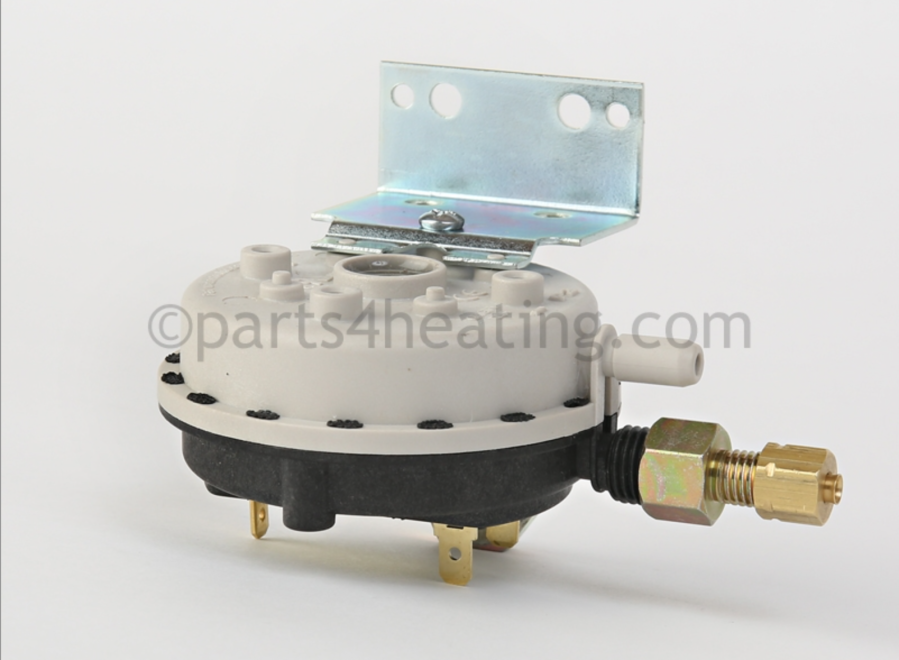*Please Note: These tests and procedures are to be performed by a qualified technician only*
Why do you need an air pressure switch? An air pressure switch is a safety precaution that senses whether or not a pressure difference is created within the boiler when it is running. When the boiler receives a call for heat (aka when you turn up your thermostat), the blower fan within the boiler starts and a pressure difference is created from the air being sucked in and the exhaust being blown out. This pressure difference inflates/deflates a diaphragm, a balloon-like component inside of the pressure switch. Once this diaphragm inflates all the way, it will trigger the pressure switch to close. Similar to a draw bridge, the pressure switch closing brings two sides of the boiler operation together, the thermostat asking for heat and the rest of the boiler operation. Having the pressure difference present bridges the electrical current “gap” from the thermostat needing the boiler to run with the ignitor and gas valve to start the next step of the ignition process.
The air pressure switch is normally open, which means that when the boiler is off, the blower is not running, and no air or exhaust is being moved. Also, there is no pressure difference created and therefore nothing is “closing the switch”. In other words, there would be nothing bridging the electrical current from the pressure switch to the rest of the system.
This pressure switch protects your home from an exhaust and carbon monoxide backdraft. Without it, these harmful fumes will linger in your home and travel back through the vents. If the exhaust is not being blown out, the pressure switch will automatically shut the boiler off to prevent any more gas and exhaust being present.

If you suspect that there may be something wrong with your air pressure switch, there are a few things to check to determine what the problem may be.
- Check the vents to ensure there is nothing blocking them such as debris or even a birds nest. If the exhaust has nowhere to go, it will not only not create the pressure difference needed for the pressure switch to operate,
- Check the fan on the blower to see if it is dirty or blocked by debris. Running
- Check to make sure all the tubing leading to the air pressure switch isn’t cracked or clogged.
- You will need to check the condition of your pressure switch. You can do this by using an ohm meter, a Manometer, or by attaching additional tubing and manually testing the pressure.
Using an ohmmeter, we want to check to see if there is a bridging of an electrical connection within the pressure switch with no wires attached. Disconnect the wires connected to the pressure switch terminals and place the ohm meter leads on the terminals. Using the ohmmeter set to read continuity or resistance, there should be a reading that is greater than zero once the boiler is turned on and actively calling for heat. The reading you should look for will either be displayed on the pressure switch or located in your manual. This means there is an electrical current running through the pressure switch and is therefore working properly.
Using the manometer, we will check for the pressure difference reading. To know what number we should be seeing, check the sticker on your pressure switch for a rating that reads, for example, “FS @ .75” WC PF-V”. In this particular example, we would want to see a reading of .75 “ WC. Ensure the ohm meter is set to read inches Water Column. Plug a tube with “T” fitting so that the original tubing connects from the blower from the T fitting to the pressure switch and the other end of the T fitting connects to the manometer. Make sure none of the tubing is kinked, because that could cause inaccurate readings. With the manometer set to inches W.C. (water column), turn the boiler on and observe the reading. If the reading is less than the inches WC printed on the pressure switch, then there is an issue with the draft or exhaust. If the reading is greater than the inches WC printed on the pressure switch and the rest of the heating cycle is not initiating, then you know that the pressure switch needs to be replaced. If the reading is greater than or equal to the inches WC printed on the pressure switch, then there is no issue with the pressure switch and the problem lies elsewhere.
With the manometer still attached, you can also manually blow into the tubing. This should create the necessary pressure difference and the ohmmeter would produce a reading greater than or equal to the printed inches WC on the pressure switch.
- If you cannot determine an issue there, check to see if there is a problem with the blower.
- If the blower is functioning properly, check to see if the heat exchanger is plugged up. If it is, clean it out.


